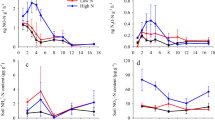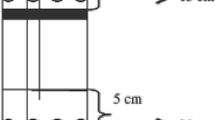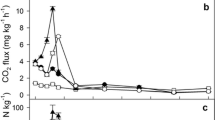Abstract
A modeling study revealed that the depth of nitric oxide (NO) production in soil is crucial for its flux, while that of nitrous oxide (N2O) is not. To verify this result, laboratory experiments with soil columns classified as Andisol (Hydric Hapludand) were conducted, with changing the depth of urea application, at 0–0.1 or 0.1–0.2 m. All the NO concentration profiles in soil exhibited a sharp peak at each fertilized layer within 5 days of fertilizer application. NO concentration in soil decreased abruptly as the distance from the fertilized layer increased. These findings imply that NO is produced mainly within the fertilized layer, but does not diffuse widely in the soil columns, because of rapid NO uptake within the soil. As a result, the NO flux from soil columns fertilized at 0.1–0.2 m depth over the 48-day study period was reduced to almost the same rate as that of the unfertilized one. The total NO emissions from soil columns unfertilized and fertilized at 0–0.1 and 0.1–0.2 m depth were 0.02, 1.39 (± 0.05) and 0.05 (± 0.03) kg N ha−1, respectively, suggesting that NO emission derived from N fertilizer could be reduced to 2% by shifting the depth of fertilizer application by 0.1 m. On the other hand, soil N2O concentration profiles exhibited a gentler peak, because of the lower uptake by soil. N2O fluxes were affected more by the soil conditions, e.g. soil water content, than the distance between fertilized depth and soil surface. The total N2O emissions from soil columns unfertilized and fertilized at 0–0.1 and 0.1–0.2 m were 0.02, 0.16 (± 0.03) and 0.25 (± 0.04) kg N ha−1, respectively.
Similar content being viewed by others
References
Akiyama H, Tsuruta H & Watanabe T (2000) N2O and NO emissions from soils after the application of different chemical fertilizers. Chemosphere — Global Change Science 2: 313–320
Anderson IC & Levine JS (1987) Simultaneous field measurements of biogenic emissions of nitric oxide and nitrous oxide. J Geophys Res 92: 965–976
Aulakh MS, Rennie DA & Paul EA (1984) Acetylene and N-serve effects upon N2O emissions from NH4 + and NO3 − treated soil under aerobic and anaerobic conditions. Soil Biol Biochem 16: 351–356
Bakken LR, Børresen T & Njøs A (1987) Effect of soil compaction by tractor traffic on soil stracture, denitrification and yield of wheat. J Soil Sci 38: 541–552
Benton J, Fuhrer J, Gimeno BS, Skärby L, Palmer-Brown D, Ball G, Roadknight C & Mills G (2000) An international cooperative programme indicates the widespread occurrence of ozone injury on crops. Agr Ecosyst Environ 78: 19–30
Bolle HJ, Seiler W & Bolin B (1986) Other greenhouse gases and aerosols: Assessing their role for atmospheric radiative transfer. In: Bolin B, Döös BR, Jäger J & Warrick RA (eds) The Greenhouse Effect, Climatic Change, and Ecosystems, pp 157–203. SCOPE report 29, Wiley, Chichester
Breitenbeck GA & Bremner JM (1986) Effects of rate and depth of fertilizer application on emission of nitrous oxide from soil fertilized with anhydrous ammonia. Biol Fertil Soils 2: 201–204
Bremner JM & Blackmer AM (1978) Nitrous oxide: emission from soils during nitrification of fertilizer. Science 199: 295–296
Bronson KF, Mosier AR & Bishnoi SR (1992) Nitrous oxide emissions in irrigated corn as affected by nitrification inhibitors. Soil Sci Soc Am J 56:161–165
Crutzen PJ (1970) The influence of nitrogen oxides on atmospheric ozone content. Q J Roy Meteor Soc 96: 320–325
Crutzen PJ (1979) The role of NO and NO2 in the chemistry of the troposphere and stratosphere. Annu Rev Earth Pl Sci 7: 443–472
Davidson EA (1991) Fluxes of nitrous oxide and nitric oxide from terrestrial ecosystems. In: Rogers JE & Whitman WB (eds) Microbiological Production and Consumption of Greenhouse Gases, pp 215–235. American Society of Microbiology, Washington, DC
Delgado JA & Mosier AR (1996) Mitigation alternatives to decrease nitrous oxides emissions and urea-nitrogen loss and their effect on methane flux. J Environ Qual 25: 1105–1111
Dobbie K E, McTaggart IP & Smith KA (1999) Nitrous oxide emissions from intensive agricultural systems: variations between crops and seasons; key driving variables; and mean emission factors. J Geophys Res 104: 26891–26899
Firestone MK & Davidson EA (1989) Microbiological basis of NO and N2O production and consumption. In: Andreae MO & Schimel DS (eds) Exchange of Trace Gases Between Terrestrial Ecosystems and the Atmosphere, pp 7–21. John Wiley, Chichester
Granli T & Bøckman OC (1994) Nitrous oxide from agriculture. Norw J Agric Sci suppl 12: 7–128
Hansen S, Mæhlum JE & Bakken LR (1993) N2O and CH4 fluxes in soil influenced by fertilization and tractor traffic. Soil Biol Biochem 25: 621–630
Hirose T & Tsuruta H (1996) Measurement of NO and N2O fluxes from the soils with the application of ammonium-and nitrate-fertilizers. Res Rep Div Environ Planning NIAES 12: 113–118 (in Japanese)
Hosen Y, Tsuruta H & Minami K (1998) Effect of the depth of NO and N2O productions in soil on their emission rates to the atmosphere. ASA-CSSA-SSSA Annual Meeting Abstracts 90: 338–339
Hosen Y, Tsuruta H & Minami K (2000) Effects of the depth of NO and N2O production in soil on their emission rates to the atmosphere: analysis by a simulation model. Nutr Cycl Agroecosyst 57: 83–98
Hou A, Akiyama H, Nakajima Y, Sudo S & Tsuruta H (2000) Effects of urea form and soil moisture on N2O and NO emissions from Japanese Andosols. Chemosphere — Global Change Science 2: 321–327
Hutchinson GL & Andre CE (1989) Flow-through incubation system for monitoring aerobic soil nitric and nitrous oxide emissions. Soil Sci Soc Amer J 53: 1068–1074
Hutchinson GL & Brams EA (1992) NO versus N2O emissions from an NH4 +-amended Beruda Grass pasture. J Geophys Res 97(D9): 9889–9896.
Itahashi S, Tsuruta H, Akiyama H, Hosen Y & Eguchi S (1998) NO and N2O emission from nitrogen fertilized soil (3) — Vertical distributions of gas concentrations in soils applied with calcium nitrate, coated calcium nitrate, or coated urea-. Res Rep Div Environ Planning NIAES 14: 47–76 (in Japanese)
McTaggart IP, Clayton H, Parker J, Swan L & Smith KA (1997) Nitrous oxide emissions from grassland and spring barley, following N fertilizer application with and without nitrification inhibitors. Biol Fert Soils 25: 261–268
McTaggart IP & Tsuruta H (1997) Report for Eco-Frontier Fellowship in 1996, Environment Agency, Japan, pp 235–247
Minami K (1994) Effect of nitrification inhibitors and slow-released fertilizer on emission of nitrous oxide from fertilized soils. In: Minami K, Mosier A & Sass R (eds) CH4 and N2O: Global Emissions and Controls from Rice Fields and Other Agricultural and Industrial Sources, pp 187–196. NIAES, Tsukuba, Japan
Mosier AR & Hutchinson GL (1981) Nitrous oxide emissions from cropped fields. J Environ Qual 10: 169–173
Mosier A, Kroeze C, Nevison C, Oenema O, Seitzinger S & van Cleemput O (1999) An overview of the revised 1996 IPCC guidelines for national greenhouse gas inventory methodology for nitrous oxide from agriculture. Environ Sci Pol 2: 35–333
Ruser R, Flessa H, Schilling R, Steidl H & Beese F (1998) Soil compaction and fertilization effects on nitrous oxide and methane fluxes in potato fields. Soil Sci Soc Am J 62: 1587–1595
Sitaula BK, Hansen S, Sitaula JIB & Bakken LR (2000) Effects of soil compaction on N2O emission in agricultural soil. Chemosphere — Global Change Science 2: 367–371
Skiba U, Smith KA & Fowler D (1993) Nitrification and denitrification as sources of nitric oxide and nitrous oxide in a sandy loam soil. Soil Biol Biochem 25: 1527–1536
Skiba U, Fowler D & Smith KA (1997) Nitric oxide emission from agricultural soils in temperate and tropical climates: Sources, controls and mitigation options. Nutr Cycl in Agroecosyst 48: 139–153
Skiba U & Smith KA (2000) The control of nitrous oxide emissions from agricultural and natural soils. Chemosphere — Global Change Science 2: 379–386
Stefanson RC (1976) Denitrification from nitrogen fertilizer placed at various depths in the soil-plant system. Soil Sci 121: 353–363
Torbert HA & Wood CW (1992) Effects of soil compation and water-filled porespace on soil microbial activity and N losses. Comm Soil Sci Plant Anal 23: 1321–1331
Tortoso AC & Hutchinson GL (1990) Contributions of autotrophic and heterotrophic nitrifiers to soil NO and N2O emissions. Appl Environ Microbiol 56(6): 1799–1805
Tsuruta H, Yagi K, Hirose T & Araya H (1995) Flux measurements of NO and N2O emitted from soils with the application of urea and slow-release nitrogen fertilizers. Res Rep Div Environ Planning NIAES 11: 49–57 (in Japanese)
Veldkamp E, Keller M & Kunez M (1998) Effects of pasture management on N2O and NO emissions from soils in the humid tropics in costarica. Glob Biogeochem Cycl 12: 71–79
Watanabe T, Osada T, Yoh M & Tsuruta H (1997) N2O and NO emissions from grassland soils after the application of cattle and swine excreta. Nutr Cycl Agroecosyst 49: 35–39
Williams EJ, Hutchinson GL & Fehsenfeld FC (1992) NOx and N2O emissions from soils. Global Biogeochem Cycl 6: 351–388
Yan X, Du L, Shi S & Xing G (2000) Nitrous oxide emission from wetland rice soil as affected by the application of controlled-availability fertilizers and mid-season aeration. Biol Fert Soils 32: 60–66
Author information
Authors and Affiliations
Corresponding author
Rights and permissions
About this article
Cite this article
Hosen, Y., Paisancharoen, K. & Tsuruta, H. Effects of deep application of urea on NO and N2O emissions from an Andisol. Nutrient Cycling in Agroecosystems 63, 197–206 (2002). https://doi.org/10.1023/A:1021150808320
Issue Date:
DOI: https://doi.org/10.1023/A:1021150808320




